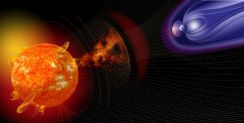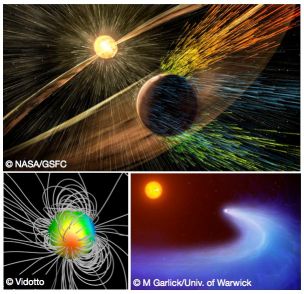
Meetings related to VarSITI in 2016
European Week of Astronomy and Space Science (EWASS2016)
4–8 July 2016, Athens, Greece
About EWASS
The European Week of Astronomy and Space Science (EWASS, formerly JENAM) is the annual meeting of the European Astronomical Society (EAS). With more than 20 years of tradition, it has imposed itself as the largest conference for European astronomy. In addition to plenary sessions and the award of prestigious prizes, the conference hosts many symposia held in parallel, as well as special sessions and meetings.
The EAS together with one of its affiliated societies, organises the annual EWASS conference to enhance its links with national communities, to broaden connections between individual members and to promote European networks.
EWASS 2016 is held for the first time in Athens, Greece and is expected to welcome over 500 astrophysicists from all over Europe and even beyond.
The deadline for abstract submission is 15 March 2016
Registration dead lines
very early: 15 Feb 2016 (360 €);
early bird: 30 April 2016 (420 €);
regular: 4 July 2016 (480 €)
Received on Jan 21, 2016
Ioannis Daglis
member of SPeCIMEN Team
Special Session SS2 Solar-Terrestrial Coupling and Space Weather:
State-of-the-Art and Future Prospects on Tue July 6, 2016
 Aims and scope
Aims and scope
The Sun, our closest star, powers life on our planet. The Sun- Earth Connection (SEC) is a fundamental research topic and its understanding is a central challenge of contemporary space physics. The Sun incessantly and intermittently forces the terrestrial and other planetary magnetospheres both with its farreaching magnetic fields and continuous plasma flows (solar wind), and via sudden releases of huge amounts of radiation (solar flares) and expulsions of magnetic flux and plasma in the heliosphere (coronal mass ejections; CMEs). This variable solar forcing is termed Space Weather, in analogy to terrestrial weather. Triggered by solar eruptions, space weather poses a serious safety threat to our space assets (e.g., satellites, astronauts) and to sensitive ground-based activities and infrastructure (e.g., power grids, polar flights of airplanes, GPS-reliant tasks). This is an extremely timely topic of basic science, given:
- the comprehensive observational coverage of the various related domains (e.g., Sun, interplanetary medium, Geospace) thanks to an array of recent missions,
- the recent advances in theory and modeling and
- the forthcoming access to the inner heliosphere via novel heliospheric missions (e.g. Solar Orbiter (SO), Solar Probe Plus (SPP), etc.).
Programme The session combines observations, data analysis, theory, and numerical simulations, to address the following questions:
- How does the coupling between solar magnetic fields and plasma flows power solar eruptions? (Emergence and evolution of solar magnetic fields, triggering and evolution of solar eruptions, coronal structure, and solar wind formation).
- How does the solar wind interact with the ejecta and how do the terrestrial and planetary magnetospheres react to the perturbed solar wind? (propagation of CMEs and Solar Energetic Particles in turbulent solar wind plasmas, development of geospace magnetic storms, acceleration of electrons to relativistic energies in the Van Allen radiation belts).
- Multi-scale observations of the Magnetosphere-Ionosphere- Thermosphere System (new results from the VAP and MMS missions).
We solicit both oral and poster contributions.
Scientific organisers
Vasilis Archontis, (University of St Andrews, UK);
Ioannis Daglis, (University of Athens, GR);
Spiros Patsourakos, (University of Ioannina, GR);
Angelos Vourlidas, (JHU/APL, USA)
Contact information:
spatsour[at]cc.uoi.gr
Special Session SS7 The effects of solar and stellar magnetic activity on planets on Tue July 5, 2016
Received on Feb 04, 2016
Aline Vidotto
member of SEE Team

Aims and scope
The magnetic activity of cool stars in the form of flares, winds and coronal mass ejections have a direct impact on planets. This activity varies with the mass, age and rotation rate of the star and can be damaging for life, even in the case of a fairly inactive star like the Sun. During periods of intense solar activity, the solar wind is enhanced and geomagnetic storms produce auroras, disrupt radio transmissions, affect power grids, damage orbiting satellites, and can be hazardous to astronauts. By analogy, the magnetic activity of cool stars may be hazardous for the creation and development of life and is therefore of potential importance for habitability.
In this Special Session, we aim to bring together observers/theoreticians whose diverse research interests are linked with solar and stellar activity and its effect on orbiting planets. Questions that will be addressed are:
- How do stellar magnetic activity influence the exoplanets orbiting main-sequence stars?
- Which lessons learned from our own solar system can be incorporate in exoplanetary research?
- How can stellar activity affect habitability?
Invited speakers
- Vincent Bourrier (University of Geneva, Switzerland)
- Gaitee Hussain (ESO, Germany)
- Ignasi Ribas (Institute of Space Studies of Catalonia, Spain)
Contact information: Heidi Korhonen
heidi.korhonen[at]nbi.ku.dk
Scientific organisers
Heidi Korhonen, University of Copenhagen, Denmark
Aline Vidotto, University of Geneva, Switzerland